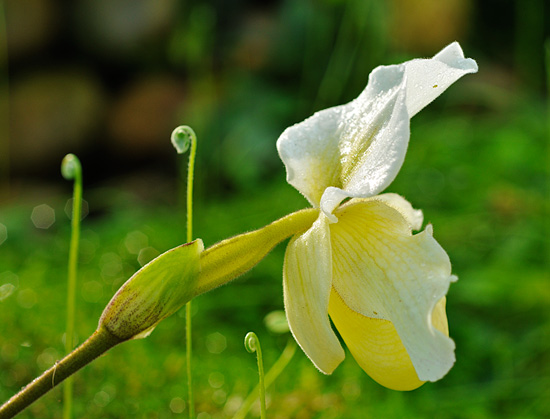
Still looking for any hints to shed some light on the albiflora phenomenon, I visited Richard Bateman in London. The white-flowered morphs “are of greatest interest to me because of their relative frequencies in the diploid and the tetraploid groups of Dactylorhiza”, he told me. “If your mind works its ways through the different diploids – incarnata, fuchsii, sambucina – they all show colour polymorphism. And they all have a certain number of very pale or white individuals.” Quite different are the observations with tetraploid Dactylorhiza species like praetermissa, majalis or alpestris. Bateman noted: “I’ve only found one albino praetermissa and one albino traunsteinerioides in 30 years of going in the field.” Quite younger is the albiflora.eu project – but up to now only some scattered findings of white-flowered Dactylorhiza majalis have been reported – and none of praetermissa or traunsteineri. As a possible explanation Bateman noted: “Presumably, in the tetraploids there has to be a minimum of four copies of a gene that is malfunctioning to cause the albinism. So I think the tetraploids are buffered against albinism by having additional copies of the genes that generate the anthocyanin pigments.”
Arguing with him about the negative connotations of the term malfunction, Bateman answered: “Most organisms are ‘designed’ to remain the way they are and not to change [substantially]. So, from a genetic viewpoint, any change that is expressed is a malfunction. I agree the malfunction could be beneficial rather than negative but most times it’s negative.”
Bateman’s main interests in research are the questions of speciation or at least the question of what might lead to evolutionary divergence between populations: “The genus level – for me at least – is solved. The species level interests me the most now. That’s were the most challenging topics still have to be addressed – how orchids speciate.” Despite a huge literature on the topic, Bateman noted, those questions are still not adequately solved. “Each time I address a particular set of orchids, the answer [to this question] is different.” So up to now, no generalization is possible. But, Bateman said, “I strongly believe that the importance of pollinator [specificity] is being exaggerated by a lot of workers.”
At least one general observation can be stated according to Bateman: “New [evolutionary] strategies are tried out constantly – more than most people believe – but I think they succeed less often than most people believe.”
In addition to such reflections on stability and change in the genetics of orchids, we wondered why hypochrome forms of Ophrys are rather green than white – obviously the Ophrys flowers still contain chlorophyll even if they lack the anthocyanins – and with good reason: “The rosette leaves of Ophrys (and Himantoglossum as well) tend to be dead before the flowers properly open”, Bateman said. “So I don’t think there is much supply of nutrient coming from [root to flower]. The flower has become autonomous … whereas in Orchis or Anacamptis the flowers are far less independent.” So, Ophrys flowers are quite special. “One of the most striking things when you start working on the flowers, cutting them up looking at them under microscope, you realize how much energy is invested in an Ophrys flower. There is a lot of tissue.”
After the visit, the Royal Botanical Gardens in Kew have been the very right place to further contemplate on the miracles of nature. (With thanks to Richard Bateman for reviewing his quotes, additional notes are marked with brackets)
